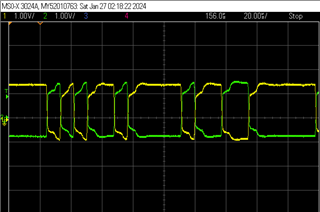Hello TI forum -
I have an application that incorporates 500 SN65HVD72 devices on a RS485 bus. The bus consists of 1000' 24AWG 120ohm twisted-pair cable with drops every 2'. Data rate is 115.2kbps. Terminations on both ends are 120ohm.
At any given time, only 1 device will be transmitting and only 30 devices will be receiving. All other drops will have their receivers and transmitters disabled. Since the SN65HVD72 transceivers are 3/20UL devices, only 213 should be connected to the bus. However, I'm wondering if this specification applies to 213 active receivers and our application therefore doesn't violate this spec and is safe to do?
We presently have this system running in our lab. The signals look excellent with no data errors. Here is an example of the signal from the furthest drop on the bus:

Thank you


